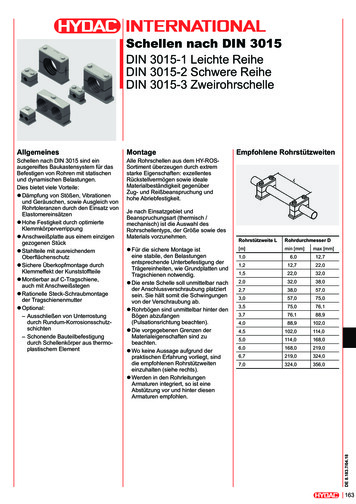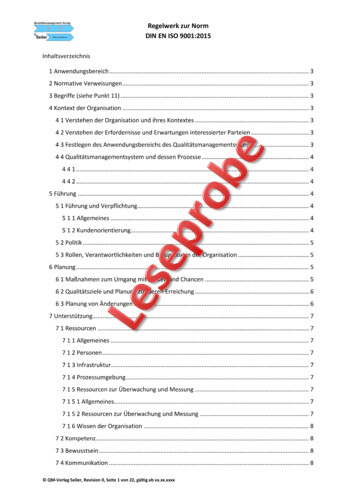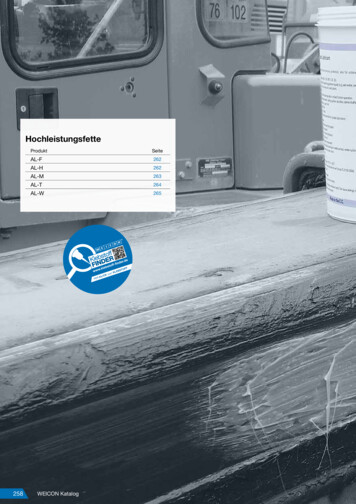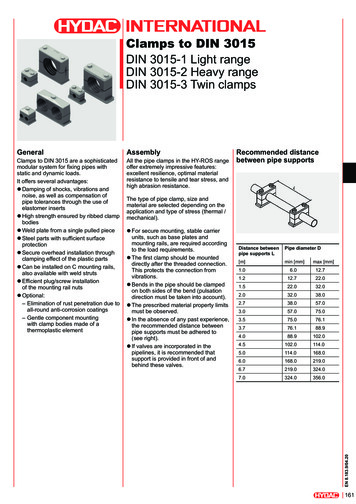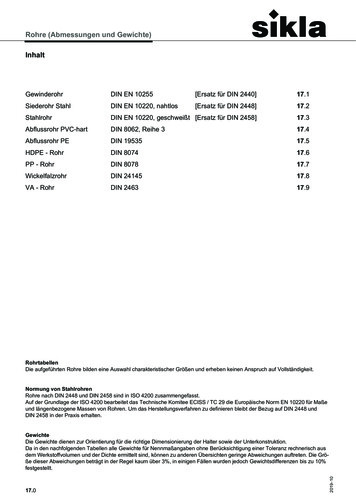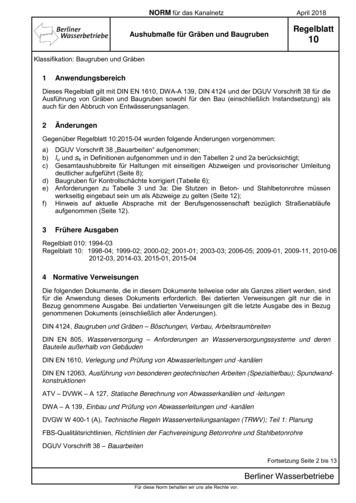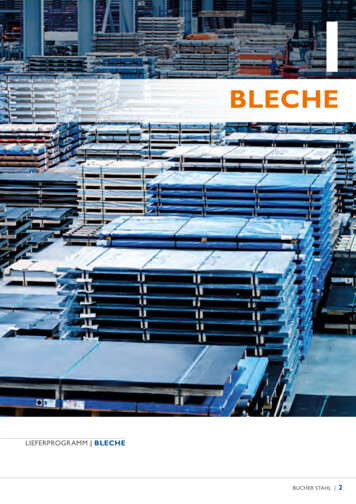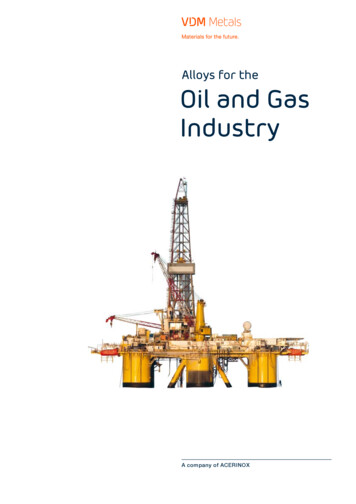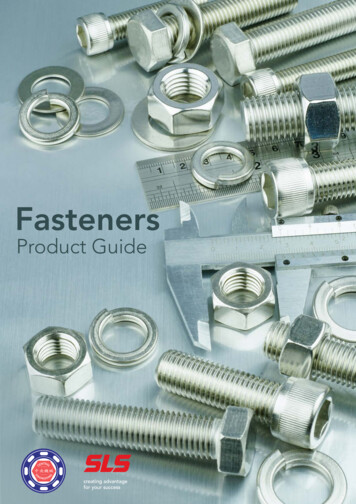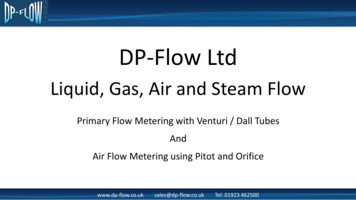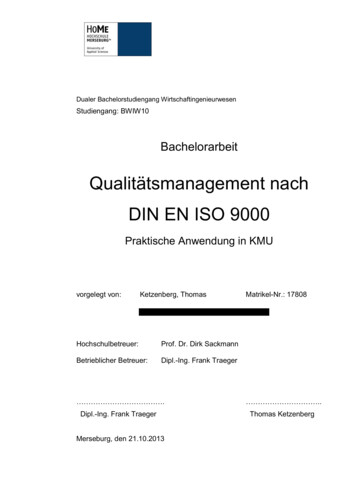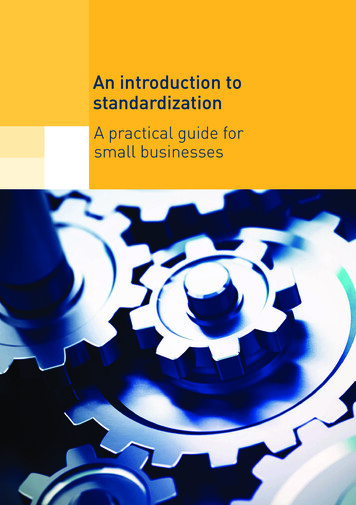
Transcription
An introduction tostandardizationA practical guide forsmall businesses
An introduction to standardization2
FOREWORDFrom standards user to standards maker –Even small businesses can take part!Actively taking part in standardization brings many advantages for c ompanies of all sizes. Standards help clarify product characteristics and promote cooperation amongmarket participants. Standards are the lingua franca of technology and innovation, providing solutions for freeglobal trade in goods and services. European Standardsopen up the EU Single Market, while international standardsprovide access to global markets. Standardization can serveas a catalyst for innovation, and helps bring solutions tothe market. Standards define interfaces and compatibilityrequirements. Anyone who ignores standards runs the riskof falling behind the competition.Using standards brings clear advantages – participationin developing these standards even more so. Those involvedin standards work come in direct contact with specialistsin other areas. Companies active in standardization thusgain a competitive lead and a preview of what’s going on themarket. Standards are also used to define safety requirements and give technical detail to the more general provisions laid down in legislation such as European Directivesor national laws. This makes active involvement in standardswork even more important for businesses in all areas. Standardization is an important strategic tool for decision- makers and management leaders alike.3
An introduction to standardizationBut small and medium enterprises (SMEs) often find it hardto keep up with and become involved in standardization. Thisis why the Association of German Chambers of Commerceand Industry (DIHK) and the German Confederation ofSkilled Crafts (ZDH) advocate a greater involvement of SMEsin standardization. DIN supports this work by providing special services for small businesses such as the SMEHelp Desk and the SME Commission (KOMMIT), in whichDIHK and ZDH are represented. KOMMIT works togetherwith SMEs to develop new strategies and possibilities forSMEs to take part in standardization. To help smaller companies become more involved in standardization, thisguide defines important terms and explains fundamentalprocesses in standardization at all levels. Providing essentialinformation that is easy to understand, this guide is crucialfor strengthening the participation of small businesses,technical associations and chambers of commerce in standards work.DINDIHKZDHGerman Institute forAssociation of GermanGerman Confederation of StandardizationChambers of CommerceSkilled Craftsand Industry4
TABLE OF CONTENTS1. Economic benefits ofstandardization. 6Gain a knowledge lead – Get involvedin the standards-making process . 6Legal security through standards . 7Access to global markets –Standards are the global languagefor technology . 8Standardization as a catalyst forinnovation . 92. How are standardsdeveloped?. 10How standards are designatedin Germany . 10Standards you probably know . 12Useful terms . 13How are standards developed? . 14How to participate in standardswork . 15Financing standards work at DIN . 17European standardization –A cornerstone of the EuropeanSingle Market . 18Development of a EuropeanStandard . 20Useful terms . 21WTO “Code of good practice forthe preparation, adoption andapplication of standards” . 23International standardization –Removing barriers to trade . 243. Important standardsorganizations. 26DIN German Institute forStandardization . 26DKE German Commission forElectrical, Electronic & InformationTechnologies . 27European standardsorganizations . 28International standardsorganizations . 294. Where can I get standardsand more information onstandards?. 305. Standards and the law . 32Legal significance of standards . 32Standards can help determine ifa product is “fault-free” . 32Liability: Standards can be usedas a measure of determining faultand allocating damages . 33“Presumption of conformity” inGerman and European law . 345
An introduction to standardization1. ECONOMIC BENEFITSOF STANDARDIZATIONGain a knowledge lead –Get involved in the standardsmaking processThe voluntary nature of standards supportsself-regulation by industry and reduces thelegislative burden on the state. By activelytaking part in standardization, companiescan help shape technical rules to better reflect their own interests while at the sametime ensuring safety interests, such as environmental and consumer protection and occupational health. Getting involved instandards work brings companies in directcontact with specialists in other areas. Influencing the content of standards bringscompetitive advantages and a preview ofwhat’s happening on the market. This increases investment security. And workingtogether with those shaping research anddevelopment helps lay the path for bringingnew technologies on the market.ADVANTAGESof participating in standardization: Represent your own interests Gain a knowledge lead Exchange information with other stakeholders Monitor the competition Gain recognition for your company6
ADVANTAGESof using standards: Easier market access Increase efficiency and lower costs in all business areas(e.g. construction, productionR&D, design, purchasing, quality assurance) Improve product safety Reduce product liability risk Enjoy a high level of customer trust by meeting qualityrequirements Simplify contract negotiationsLegal security through standardsThe use of standards is voluntary. Althoughstandards are not legal provisions, they dobecome legally binding when they are partof a contractual agreement between parties,or where their use is required in legislation.Standards are unambiguous, generally accepted rules of technology. This lendsgreater legal certainty to contracts that refer to standards. In some cases, the useof standards can become mandatory, for example in general terms and conditionsof purchase for suppliers. Even if compliance with DIN standards does not constitutea release from liability, it is an importantstep towards demonstrating due and properconduct (see Section 5 “Standards and thelaw”).7
An introduction to standardizationAccess to global markets –Standards are the global languagefor technologyStandards are the lingua franca of techno logy, providing internationally recognizedsolutions for safety, health and protectingthe environment. In international businesstransactions, standards can help build mutual trust betweencustomer and supplier, ensure compatibility andhigh quality, lower barriers to trade andsuccessfully implement inter national trade agreements.This allows companies to market their products throughout the world without having toadjust to national requirements.The aim in the EU is: “One standard,one test – accepted throughout Europe”.Uniform European Standards havesignificantly eliminated technicalbarriers to trade within the EuropeanUnion.8This has helped strengthen Germany’s position as an exporting nation, not leastthanks to Germany’s strong involvement instandardization at all levels. In fact, the economic benefits of standardization forGermany have been quantified as beingequal to 1% of Germany’s GDP.www.din.de/go/benefits-for-the-private-sector
Standardization as a catalyst forinnovationThe ability to implement new ideas and research findings as innovative products,methods and services is decisive for competitive ability. Standardization can serveas a catalyst for innovation, and helps bringsolutions to the market by defining inter faces and compatibility requirements.They are also important for new fields oftechnology, such as Industry 4.0, electro mobility and smart cities as well as for thedevelopment of new products and services.Standards also create trust between usersand market participants.EXAMPLEOne example of how standardization can be used to bring marketsuccess for an innovative area suchas e-mobility is DIN SPEC 70121.This specification describes thecommunication between chargingstations and electric vehiclesusing the “Combined Charging System”. In the interest of harmonizing this technology on bothsides of the Atlantic, DIN decidedto make this DIN SPEC availablefor free to SAE International, theUS automotive and aerospacestandards- setting organization.This will help enhance the e xportopportunities for both German andUS companies.DIN SPEC 70121Innovative companies use standardizationas a strategic instrument for increasing themarketability of their products. Standardizing aspects of an innovative product can playa key role in preparing the market for thatproduct. Using European Standards opensup possibilities for new products on the European market and ensures compatibilitywith existing systems. Deciding on how touse standards and patents for innovativesolutions is a fundamental aspect of anycompany strategy.9
An introduction to standardization2. HOW ARE STANDARDSDEVELOPED?Standards describe the state of the art atthe time of their publication. They specifyproperties, test methods, safety requirements, dimensions, etc.How standards are designated in Germany(see Section 3)10DINGerman Standard developed solely at national level andthat has primarily national significanceDIN VDENational electrotechnical standard containing requirements relating to safety and/or electromagnetic compatibility(EMC) are adopted in Germany as DIN Standards “withVDE classification”.DIN ISODIN IECDIN ISO/IECGerman publication of an International Standard publishedby ISO and/or IEC and which has been adopted unchangedinto the collection of German standards.
DIN ENGerman publication of a European Standard which hasbeen adopted unchanged by all members of the Europeanstandardization organisations CEN/CENELEC/ETSI.DIN EN ISOGerman publication of a European standard that is identicalto an International Standard and which has been adoptedunchanged by all members of the European standardizationorganisations CEN/CENELEC/ETSI.Prior to their publication, all DIN Standards are madeavailable to the public for commenting. During this “public inquiry” stage, the document is referred to as a “draft” standard, and the letter “E” (for “Entwurf”, German for“draft”) is placed before the designation.DIN SPECWhen time is of the essence:Unlike standards, a DIN Specification, or “DIN SPEC” doesnot require the participation and full consensus of all stakeholders. The development of a DIN SPEC is especially suitable for highly innovative topics and helps accelerate thetransfer of knowledge and technology.For more information on DIN SPEC and the latest specifi cations published, go towww.din.de/go/success-with-standards.DEUTSCHE NORMDIN EN ISO 9001ICS 03.120.10November 2015DErsatz fürDIN EN ISO 9001:2008 12 undDIN EN ISO 9001Berichtigung 1:2009 12Qualitätsmanagementsysteme –Anforderungen (ISO 9001:2015);Deutsche und Englische Fassung EN ISO 9001:2015Quality management systems –Requirements (ISO 9001:2015);German and English version EN ISO 9001:2015Systèmes de management de la qualité –Exigences (ISO 9001:2015);Version allemande et anglaise EN ISO 9001:201511
An introduction to standardizationStandards you probably knowDIN EN ISO 9001This standard is recognized around the world. It is almost impossible to imagine a business world functioning without it,as a properly working quality management system boostscustomer confidence, makes processes more transparentand increases the general performance and capabilities of anorganization.DIN EN ISO 216Although most people won’t recognize the number of thisstandard, they use it every day: DIN EN ISO 216 lays down thepaper formats used in most countries of the world. The A4paper size – originally specified in Germany as “DIN A4” – isone of the first subjects ever standardized.DIN EN 124You may have seen this number while walking down thestreet: Look down, you’re standing on it! European StandardEN 124 – published in Germany, for example, as DIN EN 124 –specifies the sizes of gully covers and manhole tops.DIN 5008This standard is probably one of the most widely used in Germany. Every secretary – and anyone else who has anythingto do with business correspondence – uses this standard onformats and writing styles for business letters and other professional documents. One example of the practical uses ofDIN 5008: The recipient’s address is guaranteed to fit into thewindow of a standard envelope if the letter has been writtenin accordance with DIN 5008.DIN 13157Be ready for any emergency – with the help of first aid kit“C” in accordance with this standard. DIN 13157 lists requirements for the box itself and what it is to contain: scissors,bandages and disposable gloves for medical purposes. InGermany, use of this standardized first aid kit is often legallyrequired, for instance for safety at the workplace.12
USEFUL TERMSStandardization Standardization is a systematic process by which tangibleor intangible subjects are harmonized by the joint efforts of thestakeholders for the benefit of society as a whole. Because ofits well-proven full consensus processes, standardization has ahigh democratic legitimation and complies with anti-trust legis lation.Standard A standard is a document, established by consensus andapproved by a recognized body, that provides, for common andrepeated use, rules, guidelines or characteristics for activitiesor their results.Informal, or limitedconsensus, standardization In Germany, a differentiation is made between full consensus(“Normung”) and limited consensus (“Standardisierung”) standardization. The latter includes the development of documentssuch as specifications or technical reports in a shorter process.The involvement of all stakeholders is not required, nor is thepublication of a draft for public commenting.DIN Specification A DIN Specification, or DIN SPEC, is a standards deliverabledescribing products, systems or services, and drawn up accordingto an informal standardization process (e.g. PAS).www.din.de/go/success-with-standardsState of the art According to DIN EN 45020, the state of the art is a “developedstage of technical capability at a given time as regards products,processes and services, based on the relevant consolidated findings of science, technology and experience”.Acknowledgedrule of technology According to DIN EN 45020, an acknowledged rule of tech nology is a “technical provision acknowledged by a majority ofrepresentative experts as reflecting the state of the art”. A standard is assumed to be an acknowledged rule of technology atthe time of its approval.13
An introduction to standardizationHow are standards developed?DIN Standards are the results of work at national, Europeanor international level. Anyone can submit a proposal forthe development of a new standard. Standards are drawnup according to set rules of procedure, in Germany by therelevant DIN Standards Committee, the relevant TechnicalCommittee of the European standards organization CEN(CENELEC for electrotechnical standards) or the relevantcommittee at the international standards organization ISO(IEC for electrotechnical projects).All stakeholders can take part in work on a standard. “Stakeholders” in standardization include manufacturers, con sumers, tradespersons, researchers and scientists, insurance companies, government agencies and testing bodies.Companies and organizations send their experts to participate in the relevant working bodies of a standards developing orga nization. At DIN, there are 70 standards committees,each responsible for a different subject area. National interests are represented at European and international levelwithin CEN and ISO, respectively. Being the national body responsible for standardization within Germany, DIN sendsexperts and national delegations to represent German interests. At DIN, staff members are responsible for coordinatingwork at national, European and international level.DIN Standards are reviewed at least every five years. If astandard no longer reflects the current state of the art,it is either revised or withdrawn.14
How to participate in standards workThere are many different ways to take part in stan dar diza tion. The nature of this participation depends on one’s interests and resources.P R O J E C T M A N A G E M E N T AT D I NHow you can take partAnyone can submitSteps in the processWhat happens in the standardscommitteeProposal for standards work· Decision to acceptMake commentsStandards project· Draw up contentComment on draftDraftstandard· Discuss submittedcommentsTake part in discussions· Incorporate results ofdiscussionsDINStandard List of DIN standards committees:www.din.de/go/standards-committees· Adopt final version1. Proposal for developing a standardAnyone can submit a proposal for standards work; at DINthis must be done in writing. The proposal must be well- founded and should be as concrete as possible. If a need forthe standard is established and financing is secured, theproposal is given the status of a “standards project”. Theproject is then assigned to a working body for development.At DIN there are over 3,600 working groups and committees.If necessary, a new committee is founded.15
An introduction to standardization2. Drafting the standard in a working bodyAny organization or company can send experts to DIN towork on a standard. However, all participants in this workmust pay a fee to cover the project management carried outby DIN staff. In many cases, companies agree to send an expert from a technical association to represent their jointinterests. A draft standard is then drawn up in consensus,taking the state of the art into consideration. Not all meetings need to be attended in person: Increasingly, virtualmeetings are held, allowing experts to participate from theirown workplace.The DIN website lists all current standards projects for eachcommittee, including details such as the project content,starting date, responsible working body and contact information.List of DIN Standards Committees:www.din.de/go/standards-committees3. Commenting on draftsOnce the draft standard is published, there is a period of2 to 4 months during which comments can be submitted;this is sometimes called the “public enquiry” period. ForGerman- speakers, DIN’s free draft standards portal can beused to submit comments.www.din.de/go/entwuerfeDIN’s website also lists the draft standards that are at commenting stage for each standards committee.List of DIN Standards Committees:www.din.de/go/standards-committees16
INCOME STRUCTURE(EXEMPLARY FOR 2015)Own income ca. 59%Private funding ca. 20%Public funding ca. 12%Membership fees ca. 9%Financing standards work at DINDIN provides extensive services, such as supporting expertsin their work, managing standards projects, and representing German interests at meetings held throughout the world,in some cases by holding the secretariat of an internationalworking body. The cost of these services amounts to roughly74 million euros per year.The indirect cost of these services, e.g. overhead costs, is financed through DIN’s own income, primarily from the salesof standards. The direct costs – such as personnel costs,travel costs, and non-personnel costs (e.g. interlaboratorytests) – are covered by project funds from the private andpublic sectors, with private project funds making up thelargest part.This way, by purchasing standards the users themselvescontribute to the financing of standards work. Companiesand organizations who send experts to work in the committees also contribute in the form of project funding or fees.For more ects17
An introduction to standardizationEuropean standardization – A cornerstoneof the European Single MarketThe main goal of European standardization is to unify allstandards that apply within Europe. Standards developed atEuropean level must be adopted unchanged by all nationalstandards bodies that are members of CEN, the EuropeanCommittee for Standardization. Any conflicting nationalstandards must be withdrawn. Over the past 30 years thisprinciple has reduced the total number of standards in Europe from 150,000 to about 20,000.In addition, a standard that has been developed at inter national level can be simultaneously adopted as a EuropeanStandard by means of parallel voting procedures in accordance with the Vienna Agreement. Such standards are tobe automatically adopted by the national standards organizations.Adopting International and European Standards as nationalstandards facilitates export, because this removes mostnational technical barriers to trade. Companies who makeand test products and perform services according to Euro pean or International Standards place them on internationalmarkets without any other restrictions. Because they removebarriers to trade, European Standards, are a cornerstone ofthe European Single Market. They also help improve con sumer protection, environmental protection and occupationalhealth & safety.18
The national delegation principleEuropean Standards are developed according to the nationaldelegation principle, with each country sending a delegationof experts to represent the national standpoint. In Germany’scase, DIN sends the delegation. This standpoint is drawnup in national committees that “mirror” the committees atEuropean or international level. Stakeholders can thus worktogether in their own native language – a definite advantage.By taking on the secretariat of an international or Europeancommittee, national members (such as DIN) can play aleading role in the committee’s work. It is often decisive fornational interests to be effectively represented at an earlystage of the development of a European Standard.The national delegation principle gives stakeholders a directline to European standardization, while at the same timesupporting self-regulation by industry. For example, Euro pean directives only lay down essential requirements. Theseare given technical detail in European Standards. This way,industry can itself shape the technological solutions that implement the directives.19
An introduction to standardizationDevelopment of a European StandardEuropeanCommissionand/or EFTASTANDARDIZATION “REQUEST”StandardsproposalDIN or othernational standardsorganizationEuropean or inter national standardsorganizationProject management at DIN or other nationalstandards organizationAccepted or rejectedOngoing consul tations re contentResponsible body· decides to accept· draws up time schedule· assigns to working bodyStandardsprojectWhat happens in DINWorking body· draws up contentMirror committee· discusses the proposal, etc.· develops German standpoint· sends delegates· sends expertsDraftstandardCommentssubmitted byexperts andgeneral public· discusses content· draws up nationalcomments· weighted votingPublic enquiry(commenting)FinaldraftWorking body· discusses and consolidatescommentsFinal vote· weighted votingEuropeanStandardENNational adoptionas DIN ENListed in the Official Journal of the EuropeanUnion (for “mandated” standards only)20
USEFUL TERMSThe New Approach The aim of the EU’s “New Approach” to standardization is toharmonize technical standardization within Europe. According tothe New Approach, European Directives specify essential safetyand health requirements which are then given more technical detail in the harmonized European Standards that are implementedat national level. At present there are about 30 “New Approach”European Directives. Harmonized European Standards are developed on the basis of a standardization “request” (formerly called a“mandate”) by the European Commission. Users of a harmonizedstandard can presume that they meet the essential requirementsof the respective directive (“presumption of conformity”) if theycomply with the standard.For more information: www.newapproach.orgHarmonizedEuropeanStandard Harmonized European Standards are those drawn up on thebasis of a standardization “request” (formerly called a “mandate”)by the European Commission (or EFTA). Roughly 19% of all European Standards are “harmonized” standards.These standards give detail to the more general “essential safetyand health requirements” laid down in European legislation suchas the directives. Lists of harmonized standards are publishedin the Official Journal of the European Union (OJEU). In each harmonized standard, the relationship between it and the relevantdirective is described in an Annex. Compliance with a harmonizedEuro pean Standard means that it can be assumed that the essential requirements of the respective directive(s) have been met. Although products and services in accordance with harmonizedEuropean Standards must be accepted in all EU member countries,the use of such standards remains voluntary. However, manu facturers who do not comply with these standards must provideanother form of proof that the essential requirements of the directive have been met.21
An introduction tostandardizationUSEFUL TERMSStandardization“request” A request for standardization (formerly called a “mandate”) isissued by the European Commission or the EFTA to one or moreof the European Standards Organizations (CEN, CENELEC andETSI) who then decide whether to accept or reject the request.In most cases, these requests call for the development of a European Standard to implement a European directive or regulation.Mandated standards projects follow the same procedure as forother European standards projects. Often, external consultantsare called in to make sure the standard conforms to the directiveor regulation.CE marking CE marking demonstrates conformity with the essential safetyrequirements laid down in EU legislation (such as directives). According to the New Approach, certain European directives referto harmonized standards that describe technical solutions formeeting the requirements of that directive. The CE mark is to beapplied by the manufacturer or exporter, or their representative.Some directives require conformity assessment by a neutral thirdparty, called a “notified body”, before the marking can be applied.By applying the CE mark a manufacturer declares on his/her soleresponsibility that the product meets all the legal requirementsand can thus be placed on the EEA market. It should be noted thatthe CE mark is not a quality mark, nor does it indicate that theproduct was made in Europe. As such, it is not intended for theend consumer. Other marks are used to indicate quality, such asthe German “safety tested” seal (“GS” mark).For more information: www.eu-richtlinien-online.de (German only)Certification22 Certification is the attestation by a neutral party that a product, process, system or person meets specified requirements.(From DIN EN ISO/IEC 17000)
Conformityassessment This is the demonstration that specified requirements relating to a product, process, system, person or body are fulfilled.It includes activities such as testing, inspection and certification,and the accreditation of conformity assessment bodies.(From DIN EN ISO/IEC 17000)Accreditation According to EC Regulation No 765/2008 EC, accreditation isthe “attestation by a national accreditation body that a conformityassessment body meets the requirements set by harmonizedstandards and, where applicable, any additional requirements to carry out a specific conformity assessment activity”. WTO “Code of good practice for the preparation,adoption and application of standards”National, European and international standards organizationsare obliged to adhere to the WTO’s “Code of good practice”regarding standardization: No preference is to be given to domestic productsNational standards shall not obstruct international tradeRelevant International Standards are to be adopted nationallyInternational standards are to be developed by national delegationsDuplication of work is to be avoidedInternational standards are to be developed with nationalconsensusThe body of standards is to be consistentWork programmes are to be publishedFor the public there shall be a period for submitting comments to draftsAll comments are to be given equal treatment23
An introduction to standardizationInternational standardization –Removing barriers to tradeInternational Standards describe safe technical solutions,increase safety at the workplace and help protect the environment. They provide a framework for global markets anda common technical language. The development and useof International Standards is recommended by the WorldTrade Organization (WTO) as a means of preventing technicalbarriers to trade due to national standards.Between CEN and ISO:The Vienna Agreement(1991)Between CENELEC and IEC:The Dresden Agreement(1996)24DIN represents German interests in the International Organization for Standardization (ISO), while DKE, the GermanCommission for Electrical, Electronic and Information Technologies of DIN and VDE represents Germany in the International Electrotechnical Commission (IEC). As with Europeanstandardization, national “mirror” committees decidewhether or not
a product is "fault-free" . 32 Liability: Standards can be used . (ISO 9001:2015); Version allemande et anglaise EN ISO 9001:2015 . DIN EN ISO 9001:2008 12 und DIN EN ISO 9001 Berichtigung 1:2009 12 www.beuth.de Gesamtumfang 71 Seiten D Normen-Download-Beuth-DIN Deutsches Institut für Normung e. V.-KdNr.6957518-LfNr.7368238001 .
